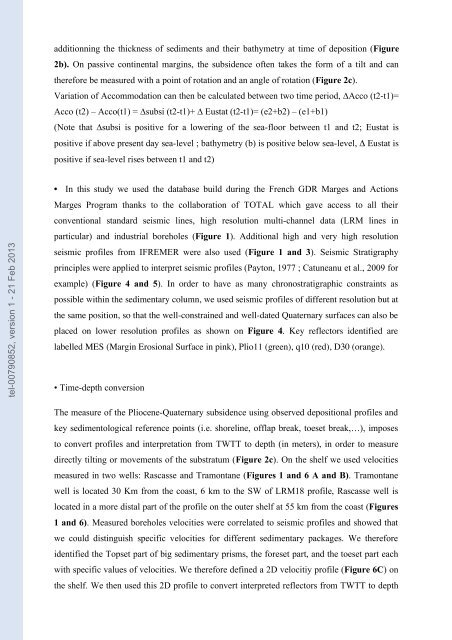Quantification des flux sédimentaires et de la subsidence du bassin ...
Quantification des flux sédimentaires et de la subsidence du bassin ...
Quantification des flux sédimentaires et de la subsidence du bassin ...
Create successful ePaper yourself
Turn your PDF publications into a flip-book with our unique Google optimized e-Paper software.
tel-00790852, version 1 - 21 Feb 2013<br />
additionning the thickness of sediments and their bathym<strong>et</strong>ry at time of <strong>de</strong>position (Figure<br />
2b). On passive continental margins, the subsi<strong>de</strong>nce often takes the form of a tilt and can<br />
therefore be measured with a point of rotation and an angle of rotation (Figure 2c).<br />
Variation of Accommodation can then be calcu<strong>la</strong>ted b<strong>et</strong>ween two time period, Acco (t2-t1)=<br />
Acco (t2) – Acco(t1) = subsi (t2-t1)+ Eustat (t2-t1)= (e2+b2) – (e1+b1)<br />
(Note that subsi is positive for a lowering of the sea-floor b<strong>et</strong>ween t1 and t2; Eustat is<br />
positive if above present day sea-level ; bathym<strong>et</strong>ry (b) is positive below sea-level, Eustat is<br />
positive if sea-level rises b<strong>et</strong>ween t1 and t2)<br />
• In this study we used the database build <strong>du</strong>ring the French GDR Marges and Actions<br />
Marges Program thanks to the col<strong>la</strong>boration of TOTAL which gave access to all their<br />
conventional standard seismic lines, high resolution multi-channel data (LRM lines in<br />
particu<strong>la</strong>r) and in<strong>du</strong>strial boreholes (Figure 1). Additional high and very high resolution<br />
seismic profiles from IFREMER were also used (Figure 1 and 3). Seismic Stratigraphy<br />
principles were applied to interpr<strong>et</strong> seismic profiles (Payton, 1977 ; Catuneanu <strong>et</strong> al., 2009 for<br />
example) (Figure 4 and 5). In or<strong>de</strong>r to have as many chronostratigraphic constraints as<br />
possible within the sedimentary column, we used seismic profiles of different resolution but at<br />
the same position, so that the well-constrained and well-dated Quaternary surfaces can also be<br />
p<strong>la</strong>ced on lower resolution profiles as shown on Figure 4. Key reflectors i<strong>de</strong>ntified are<br />
<strong>la</strong>belled MES (Margin Erosional Surface in pink), Plio11 (green), q10 (red), D30 (orange).<br />
• Time-<strong>de</strong>pth conversion<br />
The measure of the Pliocene-Quaternary subsi<strong>de</strong>nce using observed <strong>de</strong>positional profiles and<br />
key sedimentological reference points (i.e. shoreline, off<strong>la</strong>p break, toes<strong>et</strong> break,…), imposes<br />
to convert profiles and interpr<strong>et</strong>ation from TWTT to <strong>de</strong>pth (in m<strong>et</strong>ers), in or<strong>de</strong>r to measure<br />
directly tilting or movements of the substratum (Figure 2c). On the shelf we used velocities<br />
measured in two wells: Rascasse and Tramontane (Figures 1 and 6 A and B). Tramontane<br />
well is located 30 Km from the coast, 6 km to the SW of LRM18 profile, Rascasse well is<br />
located in a more distal part of the profile on the outer shelf at 55 km from the coast (Figures<br />
1 and 6). Measured boreholes velocities were corre<strong>la</strong>ted to seismic profiles and showed that<br />
we could distinguish specific velocities for different sedimentary packages. We therefore<br />
i<strong>de</strong>ntified the Tops<strong>et</strong> part of big sedimentary prisms, the fores<strong>et</strong> part, and the toes<strong>et</strong> part each<br />
with specific values of velocities. We therefore <strong>de</strong>fined a 2D velocitiy profile (Figure 6C) on<br />
the shelf. We then used this 2D profile to convert interpr<strong>et</strong>ed reflectors from TWTT to <strong>de</strong>pth

















